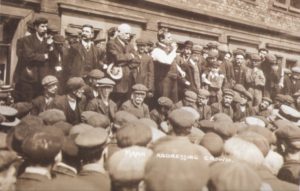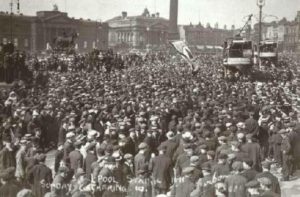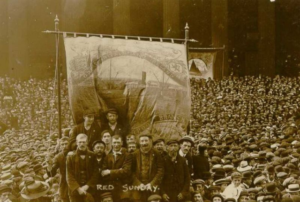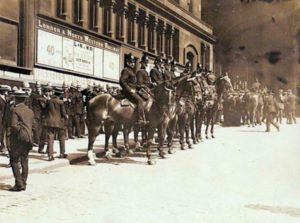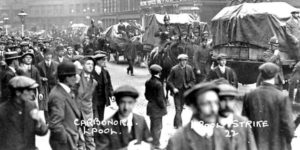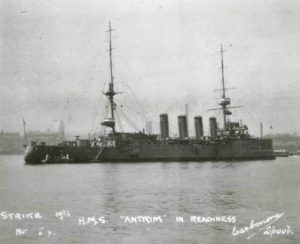TRANSPORT STRIKE 1911
Sunday 13th August 1911 saw the worst riots to occur in Liverpool. This was during the ‘Transport Strike’ and approximately 80,000 people attended a rally at St. Georges Plateau led by Tom Mann, Chairman of the Strike Committee. The strikers included dockers, railway workers, sailors and many others.
It began in Southampton where the National Sailors and Firemen’s Unions demanded improved conditions for their membership. This soon spread to other ports that included Liverpool. The demands of the ‘National Sailors’ and Firemen’s Union’ were met elsewhere but the strike continued in Liverpool.
In Liverpool, factories had shut down and it was estimated that 250,000 people were on strike. The dock system and railways grinded to a halt and nothing moved in or out of the city.
Then on Wednesday 9th August 1911 the then Head Constable of Liverpool City Police, Leonard Dunning, was granted permission to draft assistance in from nieghbouring Police Forces like Birmingham, Bradford, Lancashire and even Ireland. Troops were also drafted in to keep the peace during the dispute.
Sunday 13th August 1911 is now remembered as ‘Bloody Sunday’ or ‘Red Sunday’. Permission had been granted to hold the rally at St. Georges Plateau on that afternoon. It had also been agreed that the police and military presence would be minimal and demonstrators urged to behave in a peaceful manner.
Tom Mann made the following speech to the crowd:
“A hundred thousand people have come to the centre of Liverpool this afternoon. The authorities have allowed us to ‘police’ this hundred thousand ourselves. Why? Because they enjoy surrendering their power? Or because they’re afraid of being trampled underfoot. There’s a thin line between order and chaos. The police force of Liverpool may tread it this afternoon. A step wrong and the Mersey will rise a foot by nightfall, with largely innocent blood.
We’re gathered here today, peacefully, to demonstrate our determination to win this long and terrible battle against the employing classes and the state. What does that mean? Only this. All the transport workers of Liverpool are arm-in-arm against the enemy class.
We have sent a letter to the employers asking for an early settlement and a speedy return to work. If that brings no reply, if they ignore us, The Strike Committee advises a general strike.
In the face of the military and the police drafted into this city – and of the threat to bring gunboats into the Mersey – we can see nothing except a challenge. A challenge to every worker who values his job. A challenge to every claim each worker makes of his employer. A challenge to every right a worker should expect under common decency. Brothers, we rise to this challenge. And we meet it, head on.”
Scuffles broke out between police and protesters and the situation escalated. The Head Constable had numerous police officers from Birmingham and Leeds concealed inside St. George’s Hall together with 100 soldiers. As soon as the violence started the Police emerged from St. George’s Hall and baton charged the crowd and the Mounted Department also charged the crowd . After a short period of time the steps of St. George’s Hall were cleared but many people were injured.
Stuart Deacon, stipendiary magistrate then appeared on the plateau surrounded by troops. He then read the riot act to the crowd:
“Our sovereign Lord the King chargeth and commandeth all persons, being assembled, immediately to disperse themselves, and peaceably to depart to their habitations, or to their lawful business, upon the pains contained in the act made in the first year of King George, for preventing tumults and riotous assemblies. God save the King.”
On Tuesday 15th August, prison vans containing 90 of those convicted for involvement in the riots was attacked as they made their way down Vauxhall Road to Walton Jail. The convoy was escorted by 32 men from the cavalry unit of the 18th Hussars. Bottles and bricks were thrown at the soldiers and rioters grabbed the reins of the horses. The Hussars opened fire on the crowd and two men were killed.
On the corner of Hopwood Street and Vauxhall Road, John Sutcliffe, 20, a carter, was shot twice in the head. A docker, Michael Prendergast 29, was shot in the chest at close range by a soldier. Three other men suffered gunshot wounds during the fighting namely, Andrew Doolan, 32yrs, of Menia Street and James Miller of Lightbody Street.
PC 158’D’ was taken to hospital in a state of extreme exhaustion, caused by the blow received in the melee.
The strike came to an end on Thursday 24th August 1911.
Source: BBC, Old Mersey Times


